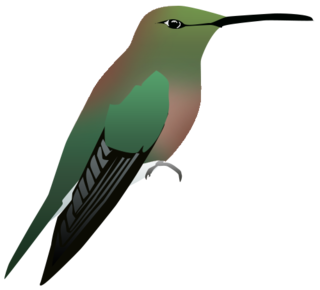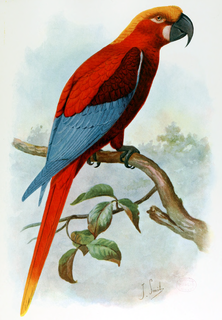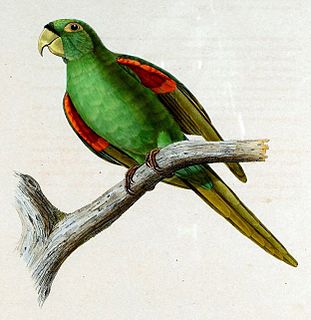 W
WThe Antillean cave rail, also known as DeBooy's rail, is an extinct rail species which occurred on Puerto Rico and the United States Virgin Islands. Bone fragments of this species were first unearthed by archaeologist Theodoor de Booy in kitchen midden deposits on the Richmond estate near Christiansted, U.S. Virgin Islands in July 1916 and described by Alexander Wetmore in 1918. The Antillean cave rail might have become extinct before the arrival of the Europeans but stories heard by Alexander Wetmore on Puerto Rico in 1912 about an easy-to-catch bird named carrao might refer to this species. The Antillean cave rail was apparently flightless and was hunted as food by the aborigines
 W
WThe Bahaman caracara, also known as Creighton's caracara, is an extinct bird of prey. It is known only from a few fossils discovered in the Bahamas and Cuba. Caracara creightoni was a scavenger and opportunistic species instead of a predator like its sister extant species. It lived during the late Pleistocene to the beginning of the Holocene era.
 W
WThe Puerto Rican crow is an extinct crow species in the family Corvidae. It lived on Puerto Rico and the United States Virgin Islands. Little is known about its habitat, but it possibly died out after the colonization of humans on these islands.
 W
WThe Cuban flightless crane is a large, extinct species of crane that was endemic to the island of Cuba in the Caribbean. The remains were found in Pleistocene deposits in Pinar del Rio. Probably derived from an early invasion of sandhill cranes from North America, it differed from that species by, as well as larger size, having a proportionately broader bill, stockier legs, and with reduced wings and pectoral girdle indicating that it may have been flightless. Currently, the only extant Caribbean crane is the Cuban sandhill crane, Antigone canadensis nesiotes, an endangered subspecies of sandhill crane endemic to the country.
 W
WThe Cuban macaw or Cuban red macaw was a species of macaw native to the main island of Cuba and the nearby Isla de la Juventud that became extinct in the late 19th century. Its relationship with other macaws in its genus was long uncertain, but it was thought to have been closely related to the scarlet macaw, which has some similarities in appearance. It may also have been closely related, or identical, to the hypothetical Jamaican red macaw. A 2018 DNA study found that it was the sister species of two red and two green species of extant macaws.
 W
WBrace's emerald is an extinct species of hummingbird which was endemic to the main island of the Bahamas, New Providence.
 W
WGould's emerald is an extinct species of hummingbird in the family Trochilidae. It was described based on a single specimen taken in 1860; it is of unknown origin, but Jamaica or the Bahamas are likely sources. Except for the type specimen, there are no records, and it is presumed extinct. While there is no information about the exact cause of extinction, the likely reasons include the loss of habitat or required food plants, and predation by introduced mammals. The holotype is currently located in Natural History Museum at Tring.
 W
WThe Guadeloupe amazon or Guadeloupe parrot is a hypothetical extinct species of parrot that is thought to have been endemic to the Lesser Antillean island region of Guadeloupe. Mentioned and described by 17th and 18th century writers, it received a scientific name in 1789. It was moved to the genus Amazona in 1905, and is thought to have been related to, or possibly the same as, the extant imperial amazon. A tibiotarsus and an ulna bone from the island of Marie-Galante may belong to the Guadeloupe amazon. In 1905, a species of extinct violet macaw was also claimed to have lived on Guadeloupe, but in 2015 it was suggested to have been based on a description of the Guadeloupe amazon.
 W
WThe Guadeloupe parakeet might have been a species of parrot that was endemic to Guadeloupe.
 W
WThe Jamaican ibis, Jamaican flightless ibis or clubbed-wing ibis is an extinct bird species of the ibis subfamily uniquely characterized by its club-like wings. It is the only species in the genus Xenicibis, and one of only two flightless ibis genera, the other being the genus Apteribis endemic to Hawaii.
 W
WThe Jamaican red macaw may have been a species of parrot in the family Psittacidae that lived on Jamaica, but its existence is hypothetical.
 W
WThe Lesser Antillean macaw or Guadeloupe macaw is a hypothetical extinct species of macaw that is thought to have been endemic to the Lesser Antillean island region of Guadeloupe. In spite of the absence of conserved specimens, many details about the Lesser Antillean macaw are known from several contemporary accounts, and the bird is the subject of some illustrations. Austin Hobart Clark described the species on the basis of these accounts in 1905. Due to the lack of physical remains, and the possibility that sightings were of macaws from the South American mainland, doubts have been raised about the existence of this species. A phalanx bone from the island of Marie-Galante confirmed the existence of a similar-sized macaw inhabiting the region prior to the arrival of humans and was correlated with the Lesser Antillean macaw in 2015. Later that year, historical sources distinguishing between the red macaws of Guadeloupe and the scarlet macaw of the mainland were identified, further supporting its validity.
 W
WThe St. Croix macaw or Puerto Rican macaw, is an extinct species of macaw whose remains have been found on the Caribbean islands of St. Croix and Puerto Rico. It was described in 1937 based on a tibiotarsus leg bone unearthed from a kitchen midden at a pre-Columbian site on St. Croix. A second specimen consisting of various bones from a similar site on Puerto Rico was described in 2008, while a coracoid from Montserrat may belong to this or another extinct species of macaw. The St. Croix macaw is one of 13 extinct macaw species that have been proposed to have lived on the Caribbean islands. Macaws were frequently transported long distances by humans in prehistoric and historical times, so it is impossible to know whether species known only from bones or accounts were native or imported.
 W
WThe Martinique amazon is a hypothetical extinct species of Caribbean parrot in the family Psittacidae. It is not known from any material remains, but was said to be similar to the red-necked amazon from Dominica, the next major island to the north of Martinique. Natives are known to have traded extensively in parrots between the Antilles, and it seems that the Martinique population was in some way related to or even descended from A. arausiaca.
 W
WThe Martinique macaw or orange-bellied macaw is a hypothetical extinct species of macaw which may have been endemic to the Lesser Antillean island of Martinique, in the eastern Caribbean Sea. It was scientifically named by Walter Rothschild in 1905, based on a 1630s description of "blue and orange-yellow" macaws by Jacques Bouton. No other evidence of its existence is known, but it may have been identified in contemporary artwork. Some writers have suggested that the birds observed were actually blue-and-yellow macaws. The "red-tailed blue-and-yellow macaw", another species named by Rothschild in 1907 based on a 1658 account, is thought to be identical to the Martinique macaw, if either has ever existed.
 W
WThe Cuban giant owl or giant cursorial owl (Ornimegalonyx) is an extinct genus of giant owl that measured 1.1 metres in height. It is closely related to the many species of living owls of the genus Strix. It was a flightless or nearly flightless bird and it is believed to be the largest owl that ever existed. It lived on the island of Cuba.
 W
WThe Puerto Rican barn owl is an extinct species of barn owl that inhabited the island of Puerto Rico in the Caribbean. It is sometimes considered to be a subspecies of the ashy-faced owl.
 W
WThe Puerto Rican parakeet or Puerto Rican conure was a species of parrot found on Mona Island and possibly in Puerto Rico.
 W
WThe Puerto Rican quail-dove is an extinct species of dove from the genus of quail-doves Geotrygon. It is only known by subfossil material from the Holocene.
 W
WTyto pollens was an extinct giant barn owl which lived in the Bahamas during the last Ice Age.
 W
WThe Cuban ivory-billed woodpecker or carpintero real is a Cuban subspecies of the ivory-billed woodpecker. Originally classified as a separate subspecies, recent research has indicated that C. p. bairdii may, in fact, be sufficiently distinct from the nominate subspecies to once again be regarded as a species in its own right.